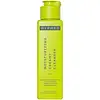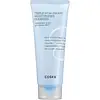What's inside
What's inside
 Key Ingredients
Key Ingredients

 Benefits
Benefits

 Concerns
Concerns

 Ingredients Side-by-side
Ingredients Side-by-side

Water
Skin ConditioningCocamidopropyl Betaine
CleansingCaprylyl Glucoside
CleansingGlycerin
HumectantSodium Methyl Cocoyl Taurate
CleansingAvena Sativa Kernel Extract
AbrasiveSodium Cocoyl Isethionate
CleansingSodium Polyglutamate Crosspolymer
Emulsion StabilisingGlycol Distearate
EmollientCeramide EOP
Skin ConditioningCeramide Ns
Skin ConditioningCeramide NP
Skin ConditioningCeramide As
Skin ConditioningCeramide AP
Skin ConditioningLaminaria Digitata Extract
Skin ProtectingLecithin
EmollientSaccharide Isomerate
HumectantTrehalose
HumectantPEG-150 Distearate
EmulsifyingAcrylates Copolymer
Styrene/Acrylates Copolymer
Xanthan Gum
EmulsifyingSodium Lauroyl Lactylate
EmulsifyingCapryloyl Glycine
CleansingUndecylenoyl Glycine
CleansingCetyl-Pg Hydroxyethyl Palmitamide
Skin ConditioningCitric Acid
BufferingSodium Citrate
BufferingC12-15 Alkyl Benzoate
AntimicrobialTitanium Dioxide
Cosmetic ColorantStearic Acid
CleansingAluminum Hydroxide
EmollientPolyglyceryl-3 Diisostearate
EmulsifyingPhenoxyethanol
PreservativeBenzoic Acid
MaskingWater, Cocamidopropyl Betaine, Caprylyl Glucoside, Glycerin, Sodium Methyl Cocoyl Taurate, Avena Sativa Kernel Extract, Sodium Cocoyl Isethionate, Sodium Polyglutamate Crosspolymer, Glycol Distearate, Ceramide EOP, Ceramide Ns, Ceramide NP, Ceramide As, Ceramide AP, Laminaria Digitata Extract, Lecithin, Saccharide Isomerate, Trehalose, PEG-150 Distearate, Acrylates Copolymer, Styrene/Acrylates Copolymer, Xanthan Gum, Sodium Lauroyl Lactylate, Capryloyl Glycine, Undecylenoyl Glycine, Cetyl-Pg Hydroxyethyl Palmitamide, Citric Acid, Sodium Citrate, C12-15 Alkyl Benzoate, Titanium Dioxide, Stearic Acid, Aluminum Hydroxide, Polyglyceryl-3 Diisostearate, Phenoxyethanol, Benzoic Acid
Water
Skin ConditioningGlycerin
HumectantStearic Acid
CleansingMyristic Acid
CleansingLauric Acid
CleansingPotassium Hydroxide
BufferingPalmitic Acid
EmollientPotassium Cocoyl Glycinate
Coco-Glucoside
CleansingGlyceryl Stearate
EmollientParfum
MaskingPolyquaternium-7
Acrylates/C10-30 Alkyl Acrylate Crosspolymer
Emulsion StabilisingSodium Cocoyl Isethionate
CleansingArachidic Acid
CleansingDisodium EDTA
1,2-Hexanediol
Skin ConditioningOleic Acid
EmollientSodium Benzoate
MaskingQuillaja Saponaria Bark Extract
CleansingCitric Acid
BufferingButylene Glycol
HumectantPanthenol
Skin ConditioningHyaluronic Acid
HumectantEthylhexylglycerin
Skin ConditioningHydrolyzed Hyaluronic Acid
HumectantSodium Hyaluronate
HumectantWater, Glycerin, Stearic Acid, Myristic Acid, Lauric Acid, Potassium Hydroxide, Palmitic Acid, Potassium Cocoyl Glycinate, Coco-Glucoside, Glyceryl Stearate, Parfum, Polyquaternium-7, Acrylates/C10-30 Alkyl Acrylate Crosspolymer, Sodium Cocoyl Isethionate, Arachidic Acid, Disodium EDTA, 1,2-Hexanediol, Oleic Acid, Sodium Benzoate, Quillaja Saponaria Bark Extract, Citric Acid, Butylene Glycol, Panthenol, Hyaluronic Acid, Ethylhexylglycerin, Hydrolyzed Hyaluronic Acid, Sodium Hyaluronate
 Reviews
Reviews

Ingredients Explained
These ingredients are found in both products.
Ingredients higher up in an ingredient list are typically present in a larger amount.
Citric Acid is an alpha hydroxy acid (AHA) naturally found in citrus fruits like oranges, lemons, and limes.
Like other AHAs, citric acid can exfoliate skin by breaking down the bonds that hold dead skin cells together. This helps reveal smoother and brighter skin underneath.
However, this exfoliating effect only happens at high concentrations (20%) which can be hard to find in cosmetic products.
Due to this, citric acid is usually included in small amounts as a pH adjuster. This helps keep products slightly more acidic and compatible with skin's natural pH.
In skincare formulas, citric acid can:
While it can provide some skin benefits, research shows lactic acid and glycolic acid are generally more effective and less irritating exfoliants.
Most citric acid used in skincare today is made by fermenting sugars (usually from molasses). This synthetic version is identical to the natural citrus form but easier to stabilize and use in formulations.
Read more about some other popular AHA's here:
Learn more about Citric AcidGlycerin is already naturally found in your skin. It helps moisturize and protect your skin.
A study from 2016 found glycerin to be more effective as a humectant than AHAs and hyaluronic acid.
As a humectant, it helps the skin stay hydrated by pulling moisture to your skin. The low molecular weight of glycerin allows it to pull moisture into the deeper layers of your skin.
Hydrated skin improves your skin barrier; Your skin barrier helps protect against irritants and bacteria.
Glycerin has also been found to have antimicrobial and antiviral properties. Due to these properties, glycerin is often used in wound and burn treatments.
In cosmetics, glycerin is usually derived from plants such as soybean or palm. However, it can also be sourced from animals, such as tallow or animal fat.
This ingredient is organic, colorless, odorless, and non-toxic.
Glycerin is the name for this ingredient in American English. British English uses Glycerol/Glycerine.
Learn more about GlycerinSodium cocoyl isethionate is a natural ingredient from coconut oil. It is an ultra gentle cleanser that gives a nice foam without drying the skin or impacting the skin barrier.
The amount of foam created depends on the amount of sodium cocoyl isethionate used in the product.
This ingredient also helps improve the spreadability of a product.
Learn more about Sodium Cocoyl IsethionateStearic Acid is a fatty acid. It is an emollient, emulsifier, and texture enhancer.
As an emollient, stearic acid helps soften skin. It aids the skin's protective barrier by preventing water loss. It also provides a gentle cleansing effect without stripping away natural oils.
Stearic acid may also be used to enhance the texture of products. It can add volume and stabilize ingredients such as water and oil. This can help water and oil ingredients from separating.
Sources of stearic acid include animal or vegetable fats/oils such as coconut or shea. It can be naturally found in butter, cocoa butter, shea butter, vegetable fats, and animal tallow.
This ingredient may not be Malassezia folliculitis, or fungal-acne safe.
Learn more about Stearic AcidWater. It's the most common cosmetic ingredient of all. You'll usually see it at the top of ingredient lists, meaning that it makes up the largest part of the product.
So why is it so popular? Water most often acts as a solvent - this means that it helps dissolve other ingredients into the formulation.
You'll also recognize water as that liquid we all need to stay alive. If you see this, drink a glass of water. Stay hydrated!
Learn more about Water